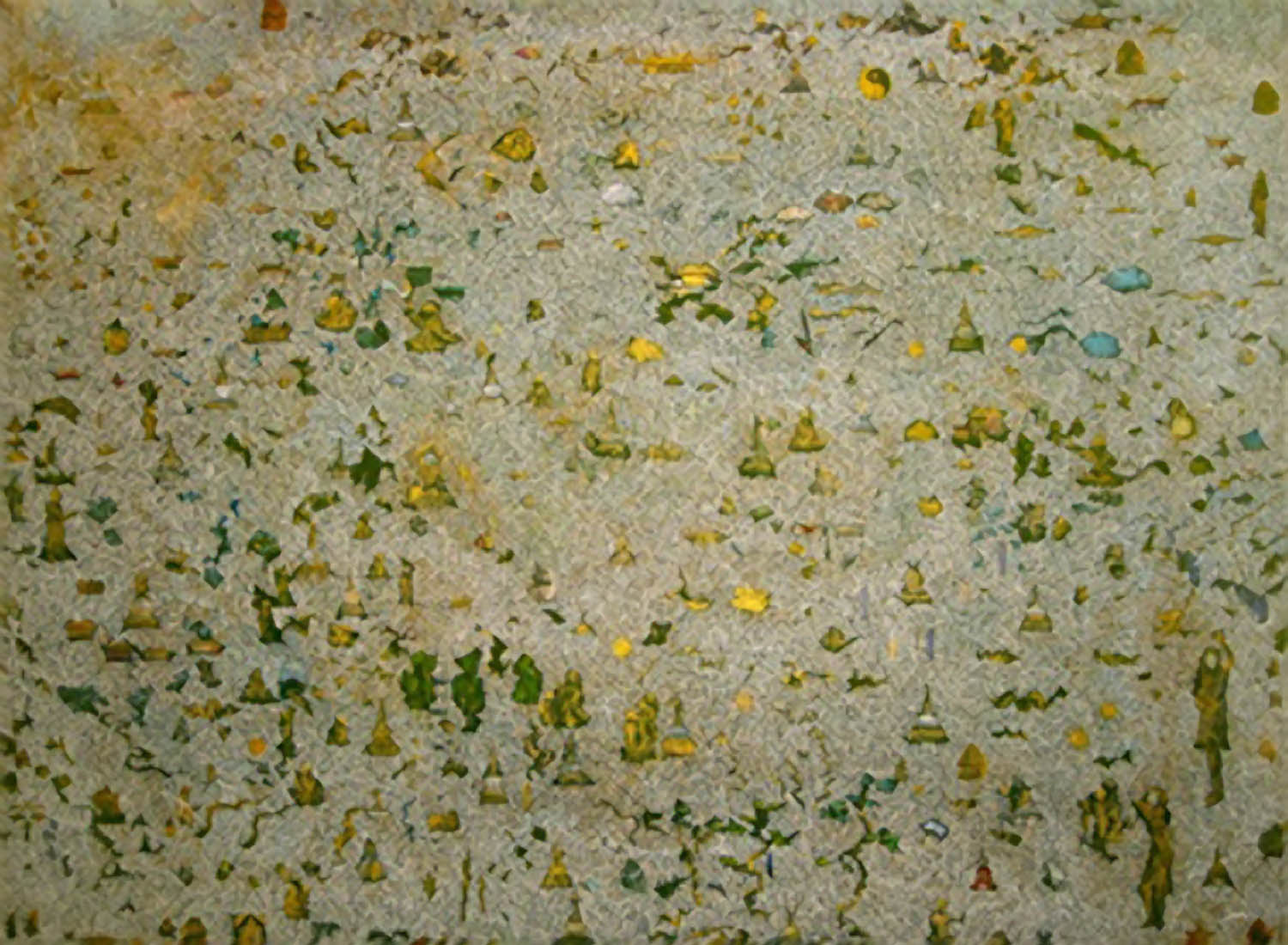Tim Johnson
Green Stupas, 1999
oil on linen
91.5
x 122.0
cm
signed, dated and titled (on the reverse)
SOLD
Provenance
Tolarno Galleries, Melbourne
Private collection, Sydney
"While Johnson evolved as an artist during the 1980s, and indeed incorporated imagery and symbolism from Aborigines and Tibetan Buddhists (among others), he never fell into the trap of appearing to kowtow to (let alone rip-off) such cultures. As an artist, as well as an individual, Johnson made a strange leap into being an active collaborator with realms that, to most Westerners, remain exotic and alien.
Again, unlike most contemporary practitioners, Johnson did not have the ego or arrogance to assume he could master traditional practices that had been handed down for generations. Instead, in a carefully planned but nonetheless humble approach, he opened his canvases to active collaboration. He has worked closely with Aboriginal artists in Papunya and Buddhist artists in Asia, including hands-on collaborations with Tibetan artists Karma Phuntsok.
The results are breathtaking amalgams of various cultures where the holy and the transcendental are almost everyday functions of social culture. Indeed, with its shimmering golds an ochres, rich deep reds and calming blues, Johnson's work, from a distance, resembles holy reliquaries, untouchable in their spiritual values. (A Crawford, 'Tim Johnson: Imitating Art', The Age, March 2005)

‘…one has to work in a symbolic space, perhaps like the Buddhist Pure Land, or the mandala itself, to create an illusory reality or a virtual reality in which the space that the artwork occupies is revealed to the audience that can read enough signs to unravel its meanings.’ (Tim Johnson, quoted in Wayne Tunnicliffe, ‘Pure Land Painting’ in Tim Johnson: Painting Ideas, Art Gallery of New South Wales, Sydney, p. 58.)
Tim Johnson’s paintings are fascinating cross-cultural documents that embody the inherent multiculturalism within contemporary society. Born and trained in Sydney, Johnson began as a conceptual and performance artist, establishing the Inhibodress art space in Sydney along with Mike Parr and Peter Kennedy. In 1975-76, Johnson travelled to North and South-East Asia, where Buddhist spirituality and culture left an indelible impression.
Johnson first travelled to Papunya, Northern Territory, in 1980, where he learned dot painting with Aboriginal artists including Clifford Possum Tjapaltjarri. After seeking permission to continue incorporating indigenous techniques within his paintings, Johnson developed a visual vocabulary that placed the vibrancy of the dot alongside symbols and icons of Asian religion and folklore. The resultant paintings are spiritual landscapes, testaments to Johnson’s connections to different aesthetic traditions around the world. He and his then-wife, the writer and sociologist Vivien Johnson, were instrumental in introducing these Central Australian artists to the art market and increasing the Australian public's awareness and appreciation of First Nations art and culture.
More recently, his contemplation of mythology has led Johnson to popular culture, with symbols from science fiction, video games and Japanese anime being incorporated alongside traditional images of the Buddha or the lotus flower. The common feature of these disparate influences is the sense that there is a shared consciousness of images and symbols from all cultures that makes sense to audiences from all backgrounds.
Tim Johnson has worked and exhibited for almost five decades, both alone and collaboratively with the likes of Karma Phuntsok, My Le Thi and Clifford Possum Tjapaltjarri. In 2009-10, a major solo exhibition, Tim Johnson: Painting Ideas toured the Gallery of Modern Art, Brisbane, the Art Gallery of New South Wales, Sydney, and the Ian Potter Museum of Art, Melbourne. He showed in 2012 at The Unseen, the Fourth Guangzhou Triennial, China, and has been included in three Biennales of Sydney.